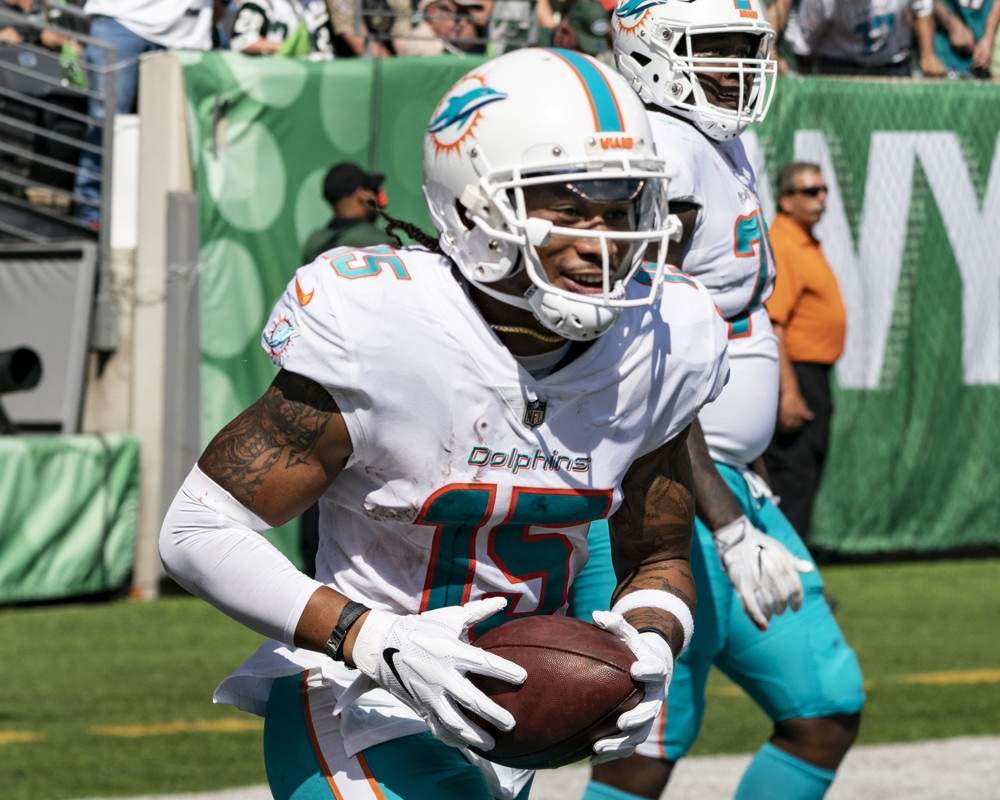
Welcome to the Monday Morning Dynasty Dive, a series where we’ll discuss a variety of topics relating to dynasty leagues and how to succeed short term and long term.
Six weeks in, what can we say we’ve learned about position value? What has been reinforced?
We all know the saying “One man’s trash is another man’s treasure.”
 Why? Well that old adage describes it all. Even at an early age it is clear to all of us that value can mean vastly different things to different people. Heck, value can even differ with the same person at a different time or in a different circumstance. Professionals like real estate appraisers and stock brokers spend the majority of their nine-to-five working to find accurate standardized values for their clients. The problem is value is fluid and can be hard to pinpoint without deciding which factors should matter in an evaluation. With this understood it is easy to see how dynasty league owners can greatly differ in their opinions of their players. These differences in evaluations have massive effects on nearly every decision a dynasty league owner makes. Today, we’ll examine a few of the main factors you can account for to make informed decisions regarding dynasty player value.
Why? Well that old adage describes it all. Even at an early age it is clear to all of us that value can mean vastly different things to different people. Heck, value can even differ with the same person at a different time or in a different circumstance. Professionals like real estate appraisers and stock brokers spend the majority of their nine-to-five working to find accurate standardized values for their clients. The problem is value is fluid and can be hard to pinpoint without deciding which factors should matter in an evaluation. With this understood it is easy to see how dynasty league owners can greatly differ in their opinions of their players. These differences in evaluations have massive effects on nearly every decision a dynasty league owner makes. Today, we’ll examine a few of the main factors you can account for to make informed decisions regarding dynasty player value.
To be successful in a dynasty league it is necessary to study your league’s specific rules. Are you playing in a 2QB Superflex? What about a TE premium league? Standard or PPR scoring settings? These questions can go a long way in helping you decide how to value positions in your league relative to one another.
For our purposes, we’ll examine a 12-team 1QB,2RB,3WR,1FLX,1K,1DST PPR League.
Positional Values in Dynasty Leagues
Positional Value – rated most valuable to least valuable
- WR
- RB
- TE
- QB
- K
- DST
Wide Receivers:
Look towards the Slot
The justification for the Wide Receiver being ranked as my most valuable positional group in dynasty leagues is most notably tied to their potential for longevity. Generally drafted between the ages of 20 to 23, wide receivers likely peak in their age 26 seasons and maintain their prime through the last game they play at age 29 (Receivers like Tyler Lockett and Albert Wilson are evidence of this). Many top receivers still contribute well into their 30’s and can reasonably be expected to give owners a minimum of WR2 numbers all the way out to their age 32 seasons. Larry Fitzgerald, a 34-year-old receiver for the Arizona Cardinals, represents the extreme nature of this trend as he has continued to produce at a WR1 level well past his expected prime (6 games in, he looks like he’s beginning to slow down a bit). Receivers also tend to have a lower risk for injury than their RB or TE counterparts as they have an approximate 4.5% chance to sustain an injury per game serious enough to cause them to miss another. All of this information points to the fact that young, stud wide receivers are worth their weight in gold in dynasty leagues.
NFL teams trotted out “11” personnel groupings (1TE, 1RB, 3WR) an eye opening 59% of the time in 2017 per SharpStats. So far this season, that already high number has risen to a staggering 63%. This has allowed even the third wideout on a team’s depth chart to participate in over half their team’s plays on a game by game basis. This abundance of opportunity is probably the largest factor in bringing receiver value down as there are a large number of startable receiver options in any given week (36 in a 12 team PPR league). In addition to this trend, receivers tend to take 2-4 years to develop on average, highlighting the need for patience when drafting to fill this position group. Be sure to also proceed with caution if a receiver changes teams as t they tend to do worse in their new locations than they did with the team they were drafted by. This isn’t always the case however, as the Ravens receivers can attest to so far this season.
Running Backs:
A top 12 RB is essential
Running backs accrue their value mainly based on the scarcity of quality options at their position. In 2017 Todd Gurley, PPR’s No. 1 RB finished with 383.3 points per FantasyPros. Le’Veon Bell, the No. 2 RB on that list, finished over 40 points (2 solid games worth) behind him. Worse still No. 12 Ezekiel Elliott (10 games played, 6 Suspended) finished with 203.2 points as the last viable RB1 in a 12-team league (180.1 points behind Gurley). What this data shows us is that the dropoff in RB quality is extremely steep as you go down the list. In our given scenario only 24 RBS (12 teams x 2 starting RBs each) can reasonably be considered starting options in dynasty leagues. Not getting one of these top 12 at the very least has an enormous impact on your ability or inability to contend. As a point of comparison, Amari Cooper, 2017’s WR No. 36 was only 151.9 points behind leader Antonio Brown. As fantasy football is at its core about points above replacement on a position by position basis, it is important to understand and internalize this trend.
The downside for Running Backs is their potential for volatility in their expected levels of production throughout their time on a dynasty roster. Injury risk for this positional group is an alarming 5.2% per profootballlogic. We’ve seen this play out in injured stars like Dalvin Cook and Leonard Fournette. This injury risk places RBs firmly atop the list when it comes to their propensity to miss starts. RBs also don’t age as well as their WR, QB, and TE counterparts. RBs generally peak in their age 26 seasons and, in rare circumstances, can contribute RB1 numbers through their age 29 seasons. Exceptions like Frank Gore do exist but don’t represent the norm. Running backs are also more easily supplanted than their WR counterparts as there often is only one spot for them on any given play. Two running back personnel groupings do occur but not nearly at the same frequency as two or three wide receiver sets. As new blood is brought in the form of rookies year after year running backs outside the elite few are constantly fighting to keep their jobs. For this reason, their value can fluctuate greatly from year to year. Don’t expect stability out of mid-level vets like Carlos Hyde.
Tight Ends:
Be patient with Tight Ends
The Tight End positional group is another one marked by scarcity in terms of quality at the top. After Gronk, Kelce, Ertz, and maybe Engram all other available starters can best be described as shots in the dark. TEs also don’t usually start to provide TE1 production until their age 25 seasons and taper out after age 32. Guys like Eric Ebron, who most dismissed this offseason, may just be entering their most productive seasons. Though the drop-off isn’t as severe as their RB counterparts the oscillating nature of their seasonal production makes them hard to trust year over year.
Tight ends aren’t an extremely risky bet in dynasty leagues as they usually don’t come at a high cost. In most circumstances nothing more than a 3rd round rookie draft pick will be required to roster a top rookie TE. Going the veteran route is also an option as in all but the deepest leagues TE streaming is a usable strategy. However, like running backs, all but the elite TEs tend to get phased out of starting positions fairly frequently relative to their peers.
Quarterbacks:
QBs aren’t very hard to come by and can represent value for many seasons
QBs like Tom Brady and Aaron Rodgers can be expected to contribute well into their late 30s/early 40s. QBs usually don’t peak until their age-27 season and can maintain their peak much longer than any other position group. They are also relatively consistent scoring wise in comparison to their peers. As an added bonus, even league average quarterbacks rarely get injured (2.5%) and don’t need to worry about losing their jobs at a rate anywhere near any other position group. The quarterback is as stable an asset in dynasty leagues as they come. A quarterback with an excellent supporting cast, Like Kansas City’s Pat Mahomes, can be a league-winning piece year over year.
If QBs are so stable why the low value you ask? Well it’s a simple case of supply and demand. In a-12 team 1-QB league every QB down to QB 12 is immediately startable. If we assume every team grabs a backup there should still be 8 starting NFL QBs not rostered in the league. Even more concerning, the difference between QB1 and QB 24 in 2017 was a mere 160.6pts. So far this year 67.9 points separates Mahomes (QB1) from Smith (QB24). Based on this understanding it is clear that this deep position group is the easiest group to stream in fantasy. Outside of the top 24, there are a number of QBs every year that provide high-end QB1 numbers sporadically (Brock Osweiler is an example this week). Attentive owners will be able to identify these opportunities.
An in depth analysis of kickers and DSTs isn’t necessary because of the bevy of streamable options.
I hope you found this information useful and urge you to factor in these guidelines when making decisions about value in your dynasty leagues. We’ll discuss another dynasty topic next week.
Agree? Think I’m Nuts? Let me know on Twitter @FF_Wonderkid
 Ready to amp up your Fantasy Football game even more? Check out The Fantasy Black Book Show, where Joe Pisapia, Scott Bogman, and The Welsh bring the goods every week.
Ready to amp up your Fantasy Football game even more? Check out The Fantasy Black Book Show, where Joe Pisapia, Scott Bogman, and The Welsh bring the goods every week.
